Weekly Email – The Sixth Sunday of Easter
Documents
Dear friends,
Our online Zoom Theology Seminar met this week and discussed two intriguing new books about Our Lady. They were Brant Pitre’s “Jesus and the Jewish Roots of Mary” and Chris Maunder’s “Mary the Founder of Christianity.” It was good to begin Mary’s month of May with a time of theological reflection on her role in the history of our salvation.
The two books could not be more different. Pitre’s is an exploration of the way in which a number of the New Testament’s assertions about Mary are rooted in the narrative, symbol and metaphor of the Hebrew Scriptures. In other words, he takes a fundamentally typological approach, looking at how Mary’s role is prefigured in the Old Testament, and how our understanding of her is informed by narrative echoes from the stories of ancient Israel.
Maunder, by contrast, takes a more sceptical and historical-critical approach. He sees the story of Mary more as the history of a myth, and situates the creation of Mary’s image within tensions at the heart of the life of the early church. He clearly comes from a tradition that does not feel bound by the traditional teachings of the Gospel regarding Mary. However, for as liberal as his perspective might be, he intriguingly asserts that Mary may have had a far more influential role in the life of the Jerusalem church than the text of the New Testament describes. For him, the assertion of a kinship bond with Mary may have been the way people established the legitimacy of their claim to exercise authority in the apostolic church.
It may not surprise you to know that many people in our discussion group struggled with Maunder’s book more than with Pitre’s. Apart from anything else, substantial parts of Maunder’s work are spent making speculative assertions remarkably difficult to prove, such as that Our Lady was probably the “Mary of Clopas” mentioned at the Cross in John’s Gospel, or that Clopas was, in fact, the Beloved Disciple. However, many of our participants felt it was a useful exercise to contrast two radically different approaches to the figure of Mary, even if one of them was less palatable to a committed Catholic perspective than the other.
The parts I found interesting in Pitre’s book were chapters that explored two important typological images applied to Mary that I hadn’t considered much before: that of the “Queen Mother” in Ancient Israel; and that of Rachel as a type of Mary.
The chapter on Mary as “Queen Mother” may initially sound a little comical to English ears – but this, in fact, has nothing to do with the theological significance of Elizabeth Bowes-Lyon! Rather, it has to do with the figure of the mother of the davidic king within the royal court of ancient Israel. Pitre asserts the King’s widowed mother with have had greater status than the King’s wife. As “Queen Mother,” she was able to exercise a significant intercessory role and excerted great influence over the king at court, as well as patronage and protection.
Mary being seen in this light may make sense of a number of assertions we read in the New Testament: Elizabeth referring to her as the “Mother of my Lord”; the way in which the Magnificat speaks of Mary’s exaltation amongst those who had thrones but who have been thrown from power; or the way in which the Woman of Revelation 12 is the mother of the messiah crowned with stars. This image roots in the scriptures that instinct that the earliest Christians had that Mary exercises an intercessory role as a result of the proximity she shares in heaven to her Son.
I also found the parallels drawn between Our Lady and Rachel (the mother of the Patriarch Joseph) in Pitre’s book really fascinating. Just as Joseph (of coat of many colours fame) is often seen in patristic comment as a type of Jesus (both go down to Egypt and both are rejected by their own, only to save them), so his mother Rachel shares similarities with Mary. Rachel is seen as an intercessory figure in Jewish tradition, and the curious oracle in Jeremiah 31.15 in which Rachel is seen weeping for her children as Mother of Israel points to Mary as Mother of the church.
Both works reminded us that whatever our perspectives on Mary, any attempt to make theological assertions about her must begin with the witness of the scriptures – and that must include the voice of the whole of scripture, not just the New Testament.
As we make our way through this month of May, traditionally devoted to Mary, let us give thanks for the Mother of God, who points to Christ and intercedes for us with him who, on the cross, gave her to be our mother also.
Fr Peter
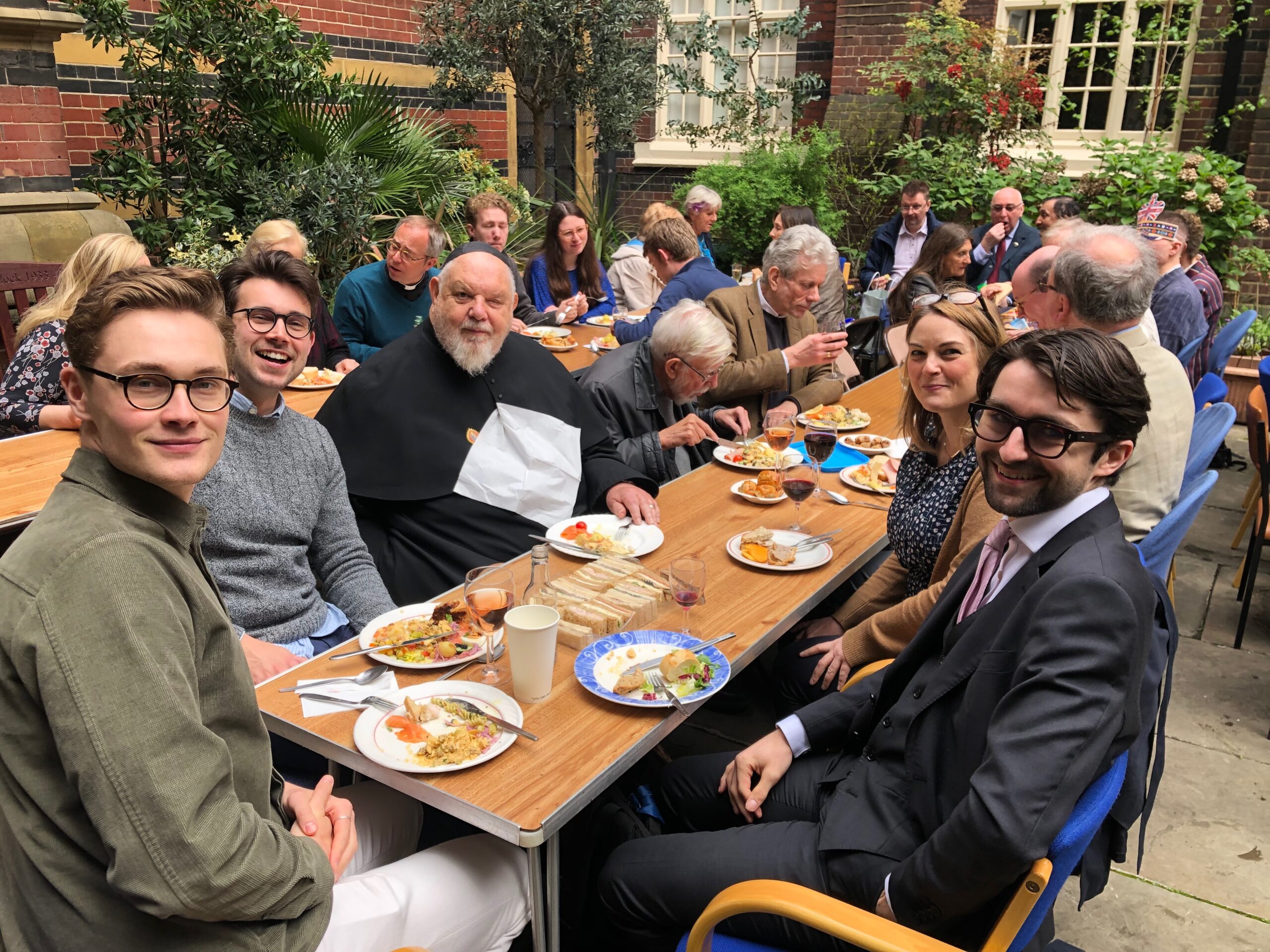
A splendid parish lunch was enjoyed by all on Sunday in honour of the Coronation of Their Majesties the King and Queen.
Thanks for Coronation Sunday
Our heartfelt thanks go out to all who contributed to our splendid Coronation Sunday parish lunch.
It was a wonderful event with a vast spread of food! Many thanks indeed to all who brought dishes, helped lay out the food, prepare tables, serve drinks, and who helped with tidying away and washing up. A particular word of gratitude should be expressed to Kate Hodgetts and Chris Self for their sterling work in organising and masterminding the whole day.
We hope to organise a similar event in three weeks’ time for our Friends Sunday on 28th May. Please be in touch again with Chris and Kate to let them know what you are able to bring. We are sure it will be just as delightful a lunch as the one we have just celebrated together!

Fr Alan and Fr Peter were very pleased and excited to visit Westminster Abbey first thing on Thursday morning to see the Coronation Theatre before it is pulled down on Saturday. What an honour to be able to witness this sacred proscenium at the heart of our nation’s life, to see St Edward’s Chair in place on the Cosmati sacrarium, and to pray for our new King and Queen.
Society of Mary May Devotion
Fr Peter and Fr Alan will be taking a group from All Saints’ to the Society of Mary’s May Devotion at S. Silas’, Kentish Town, tomorrow, Saturday 13th May.
This begins with a Solemn Mass at 12 noon followed by a joyous procession through the streets of Camden Town to Holy Trinity, Hartland Road, where there is a lunch, followed by Vespers and Benediction at 4.00 pm. It is a wonderful way of celebrating and proclaiming our faith. Let Fr Alan know if you are interested and wish to come.
Forthcoming Guest preachers
Ascension Day High Mass
Thursday 18th May 2023 – 6.30 pm
Preacher: The Revd Steven Brookes, Chaplain, The Royal Hospital Chelsea, and Deputy Priest in Ordinary to His Majesty the King.
Friends of All Saints’ Sunday High Mass followed by parish lunch.
Sunday 28th May 2023 – 11.00 am
Preacher: The Revd Steve Rice, Rector, St Timothy’s Episcopal Church, Winston-Salem, North Carolina.
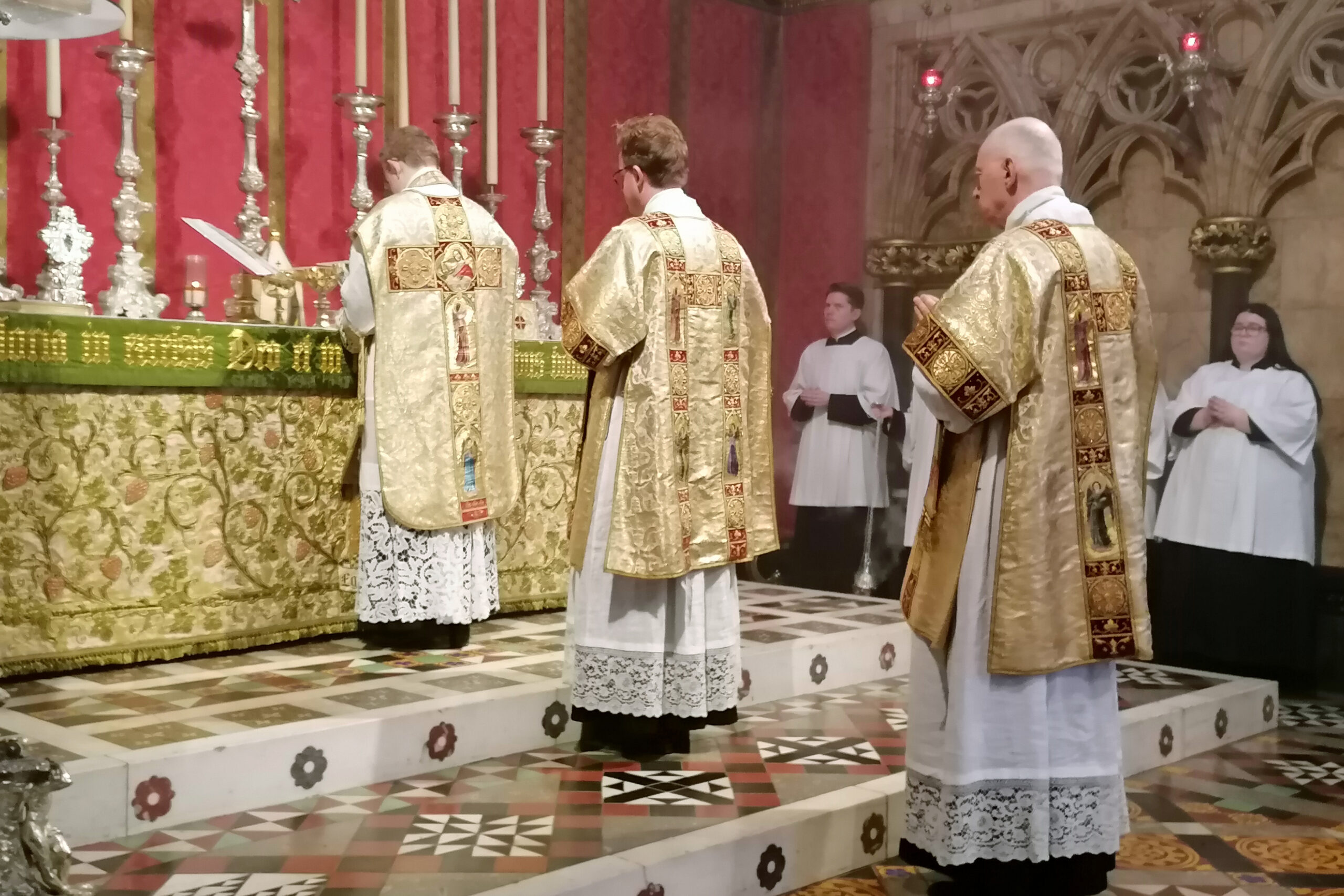
You can watch the High Mass for Easter 5 offered in thanksgiving for the Coronation here. The Mass setting was Howells’ Coll. Reg., the Offertory Motet was Parry’s I was glad, and the liturgy finished with prayers for the King and Queen and the National Anthem.
Eurovision Song Contest Party
Tomorrow evening, Saturday 13th May, Fr Alan will host a Eurovision Song Contest party at his home for our young adults. This will involve watching the Song Contest and having supper together as we enjoy an evening of Eurostrash fun! Please be in touch with Fr Alan if you would like to come.

APCM
The Annual Parochial Church Meeting and the Annual Meeting of Parishioners will take place on Sunday 21st May 2023 after the High Mass at 12.30 pm. The parish’s annual report will be available early next week and will be sent out as part of the weekly parish email next Friday. If anyone wants a copy before next Friday, please email the parish office and we will be happy to email you one.

We were so lucky last Sunday with the weather – rain had been forecast all week, but on the day itself, beautiful sun made our parish’s Coronation lunch in the parish’s courtyard possible after all.
Walsingham National Pilgrimage
The National Pilgrimage to the Shrine of Our Lady of Walsingham takes place on Monday 29th May 2023. As usual, we will be organising a coach for the day to take pilgrims to Walsingham and back. It will depart from Margaret Street at 7.30 am, and return to London, setting off around tea time, and arriving back in London by the late evening.
The cost is £20 per head. In order to book a place on the coach, please contact the parish office and make a payment to our office administrator, Jonathan.
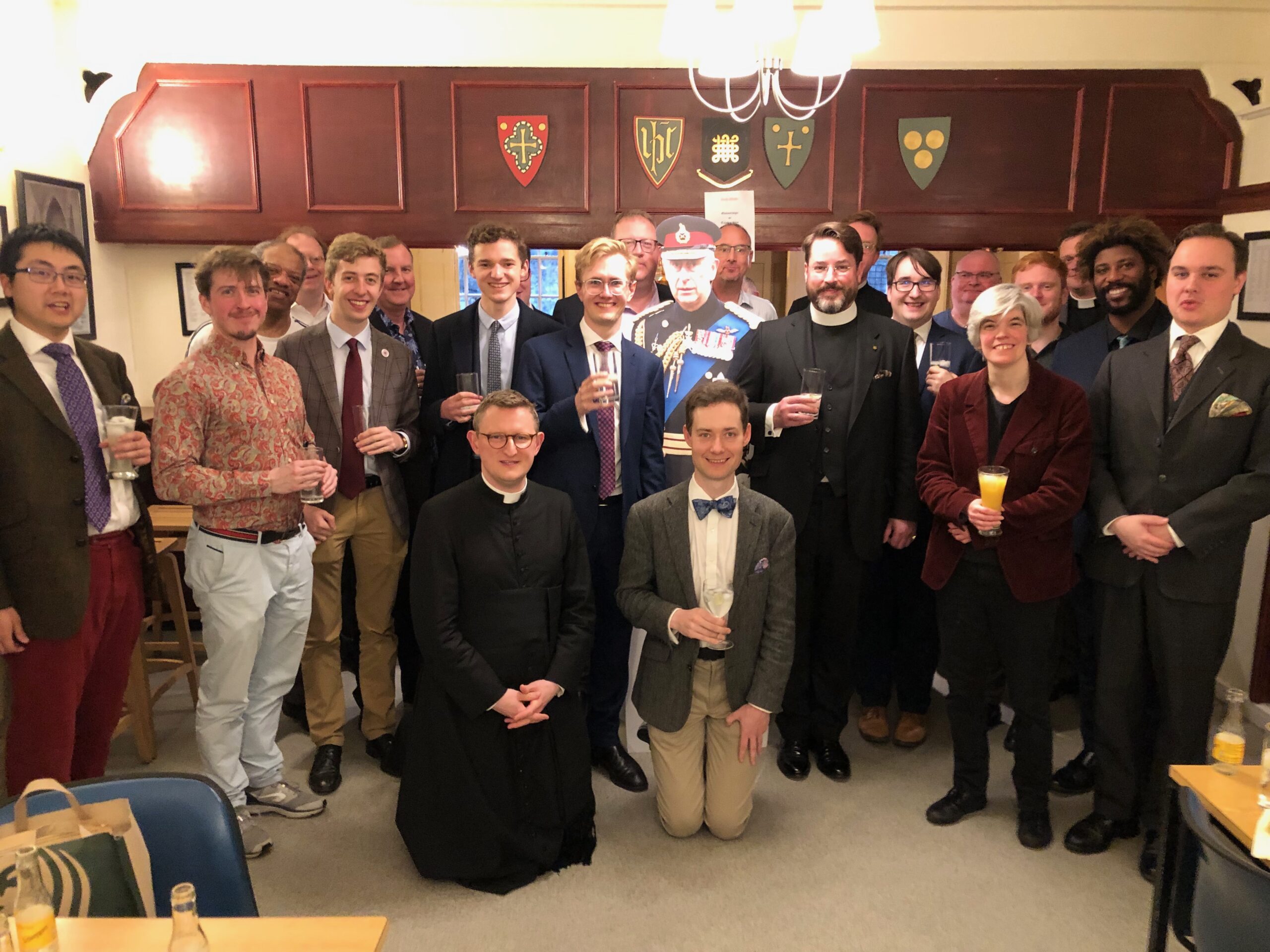
On Sunday night after Evensong, everyone in our parish bar decided to have a group photo with the King to celebrate the Coronation!
Next Zoom Theology Seminar
Our next online Zoom Theology seminar will take place on Tuesday 11th July 2023 at 7.00 pm. It will be entitled, “Theologies of the Holocaust.”
Parishioner of All Saints’ Josh Dolphin spent a summer placement at Yad Vashem learning about the work of the World Holocaust Remembrance Centre. Josh will introduce a discussion thinking about Christian and Jewish theological responses to the Holocaust and ways in which we remember and commemorate that terrible period of European history.
The Zoom link for this seminar can be found on our parish website here.
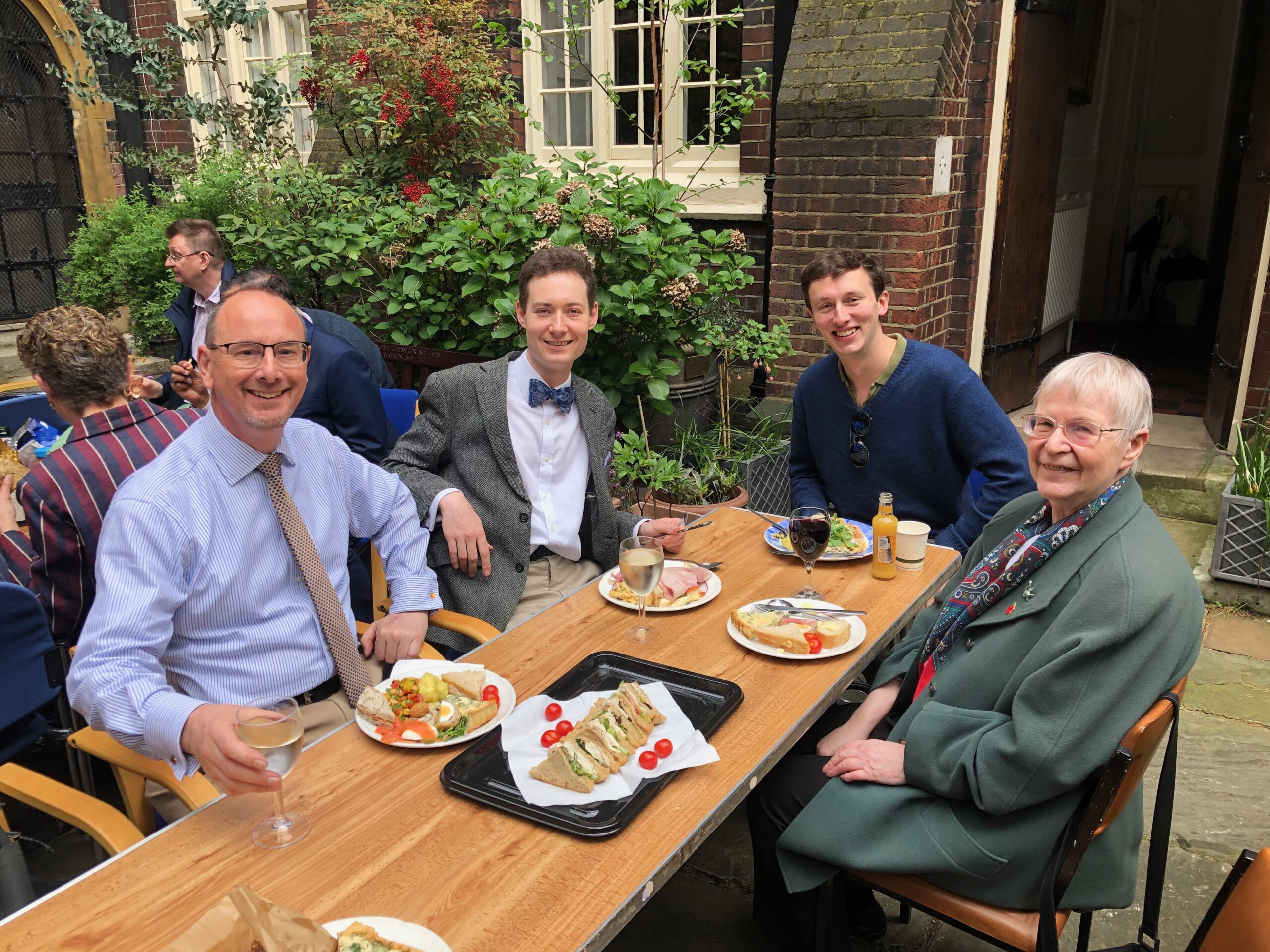
Coronation Culinary Delights
Last Sunday’s parish lunch saw a number of remarkable dishes prepared by the parishioners of All Saints’ in celebration of Their Majesties’ Coronation.
One of the most notable savoury dishes was that provided by Simon Rainey, who created a wonderful platter of smoked salmon, with the KIng’s and Queen’s cyphers picked out in anchovies. It was truly beautiful and tasted delicious!

[Simon Rainey’s splendid seafood creation: “Panaché de monogrammes royaux au saumon.”]
Many people, of course, baked Coronation Quiches and it was intriguing to compare the different results. Some were creamier, some had deeper filling, some with more cheese and tarragon, but all were delicious!
Some voices were worried the recipe would be a little bland, but it became clear it is the tarragon and cheese that hold it all together and give the Coronation Quiche its really delicious flavour. It’s certainly not worth holding back on the amount of tarragon you add.

[Two Coronation Quiches from the Vicarage: the Vicar’s crimped edges were not up to his usual standards, but the filling tasted good!]
In the realm of leavened baking, Genevieve Gomi triumphed with two wonderful “Couronnes des Rois.” You may remember this is a French dish which she prepared for us for Epiphany. She thought the connection with kings was a suitable excuse to make this delicious brioche again. It was very nice indeed, and is scented with orange blossom.

[Left: Genevieve Gomi’s “Couronnes des Rois”.]
In the category of jellies and trifles, Fr Peter made a special Pina Colada Coronation trifle. It contains a base of pineapple, sponge and huge amounts of the rum cocktail “Pina Colada” (made in proportions of roughly a third pineapple juice, a third coconut cream, a third rum). This was then topped with a layer of custard, then whipped cream. A pint of rum went into it in the end!

[The parish’s Pina Colada Coronation Trifle receiving its various layers.]
In the arena of patisserie and icing, Shawn Welby-Cooke has produced an outstanding marvel of a cake in the shape of the Crown of St Edward. His icing work is really first-rate. It hardly even looks like a cake, it’s so realistic, and really is an outstanding achievement! It could easily hold its own in a national cake competition or indeed the Bake Off!!

[Shawn Welby-Cooke’s magnificent Crown of St Edward cake. It is so realistic, one has to stop oneself from picking it up and trying it on!]
The death of Molière
In last Sunday’s sermon, Fr Peter drew on the famous story of the death of Molière as a homiletic illustration. Molière’s death has gone down as one of the most famous incidents in French dramatic history.
Fr Peter was seeking to make the theological point that the King’s vocation is a life-long consecration, sealed and made public at his Coronation. It isn’t a role that he can lay aside like an actor ceasing to play a part, but an orientation of his whole life to service. You can watch the sermon again here.
On that fateful evening of 17th February 1673, Moliere played the role of Argan in the comedy, Le Malade Imaginaire. It is about an obsessive hypochondriac who spends the play convinced he is ill and endlessly on the verge of death, constantly coughing, wheezing, spluttering, wanting to be seen by endless doctors and taking countless remedies, potions, and cures.
The problem was that during the performance, Molière had an enormous haemorrhage. As he wheezed, staggered and gasped on stage, coughing up blood and desperate for help, the audience just laughed all the more, thinking it was the best performance of his life.
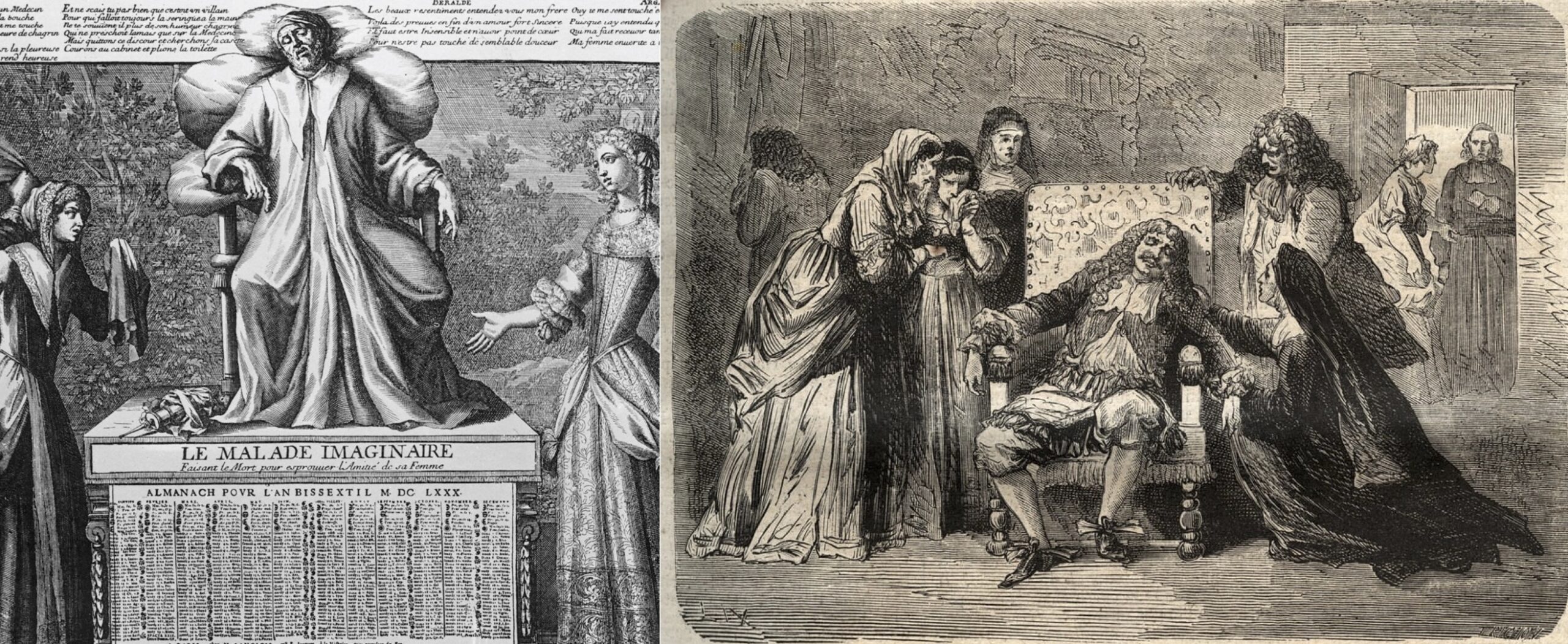
[Moliere’s (in)famous last performance as Argan in Le Malade Imaginaire.]
The scenario is not dissimilar to the death of Tommy Cooper, who also died on stage with the audience in stitches, thinking his collapse from a heart attack was part of a hilarious gag.
Events on stage, however, were merely the first part of an evening of political and theological drama. Molière insisted on finishing the play, but collapsed again and was taken, gravely ill, in a Sedan chair to his home.
Two different priests were sent for in succession to give the great dramaturge the last rites, but both refused to come, in disapprobation of the theatre and of its perceived connection with loose living. Molière’s plays had lampooned high society and the church so acutely that he had created strong enemies within the ecclesiastical hierarchy. Both the priests who were initially sent for insisted he had to repent of the stage before they would come, and by the time a third priest was found, Molière was already dead, accompanied only by a couple of nuns who had come to help him.
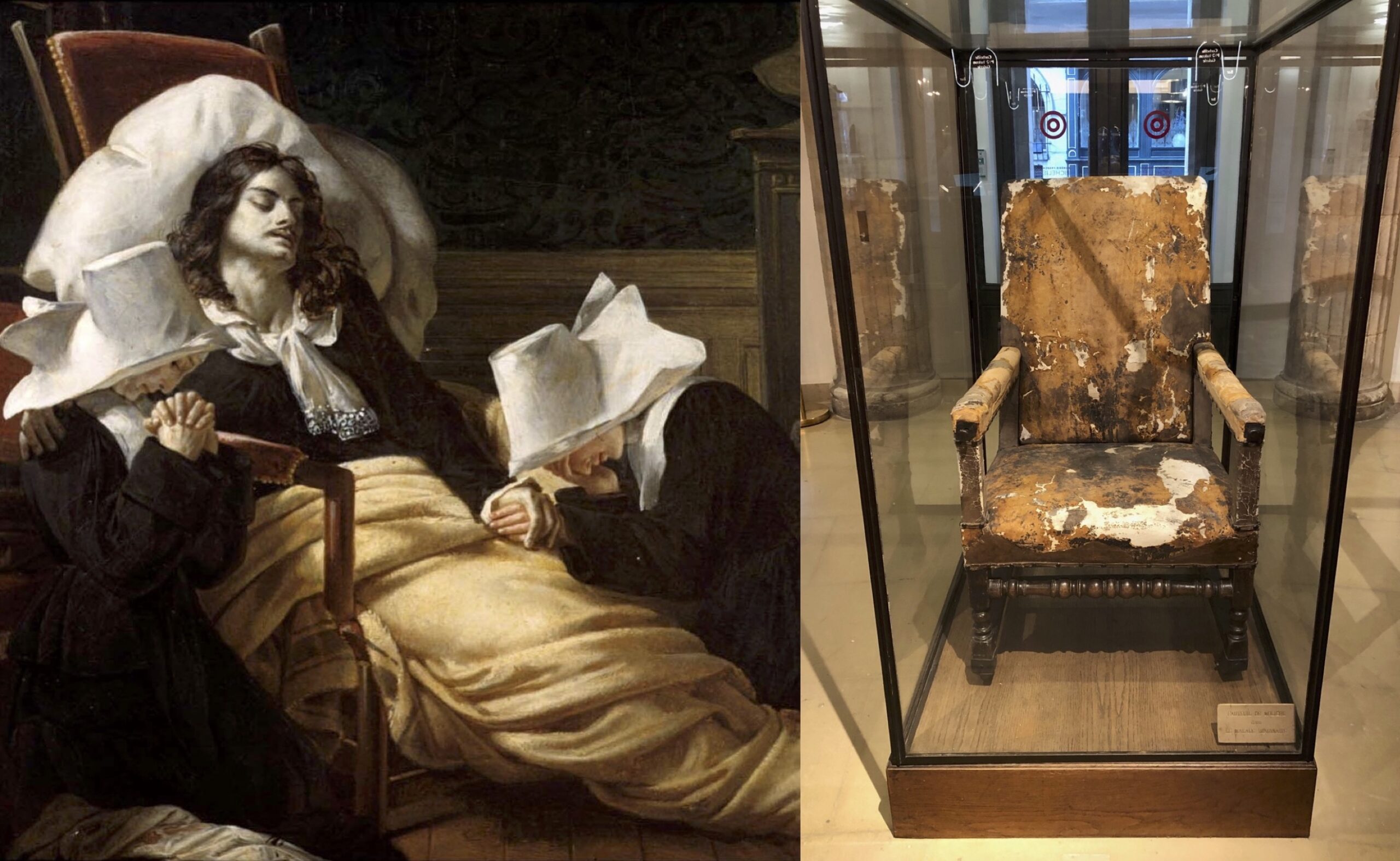
[Left: the death of Molière. Right: the famous chair Moliere sat in during his last performance in Le Malade Imaginaire, now preserved in a glass case at the Comédie Francaise, seen and photographed by Fr Peter two weeks ago.]
Yet further intrigue surrounds Molière’s burial. Because he died an unreconciled and unrepentant actor, he was denied burial in consecrated ground. The Curé of St Eustache refused him a funeral. Molière’s redoubtable and feisty wife Armande petitioned the Archbishop of Paris, who denied her request for a Christian burial, and it was only when she approached the King himself that a compromise was found – that Molière could be buried in consecrated ground in the Cemetery of St Joseph, but the funeral had to happen at night, with minimum ceremony and the grave had to be in the portion of the cemetery reserved for unbaptised babies.
Even to this day much debate exists as to where Molière’s body actually ended up because the nascent French Republic dug him up (or at least a body they thought was his!) as a revolutionary hero and moved his remains around Paris until they eventually ended up in a weird new institution called the Museum of French Monuments. This housed a collection of nationally important objects saved from revolutionary destruction along with the confiscated property of dissolved religious houses, and had a mausoleum for Molière.
There Molière stayed until a spirited and enterprising man called Nicholas Frochot came along. He was Prefect of the Seine and was trying to establish a new burial ground in Paris, which was to become the famous Père Lachaise Cemetery. He realised that the only way people would buy plots in his new cemetery was to ensure there were some famous personalities in there already whom people would want to be buried beside. He launched an extraordinarily successful project aimed at finding and reburying famous bodies in his new graveyard. As part of this marketing drive, he managed to get Moliere’s (alleged) bones transferred to the Père Lachaise Cemetery in 1804, and this prompted an enormous rush of interest in it as the burial place of choice for the rich and glamourous.

[Molière’s current alleged resting place at the Père Lachaise Cemetery, Paris.]
More significant yet, however, is the way in which the fateful evening of Molière’s death created a strong superstition in French theatre against ever wearing green on stage. Molière was wearing a green suit to play Argan the night he died, and it has become the custom of French actors never to wear green, especially on stage, for fear of meeting the same fate as Molière himself!
Attendance last Sunday
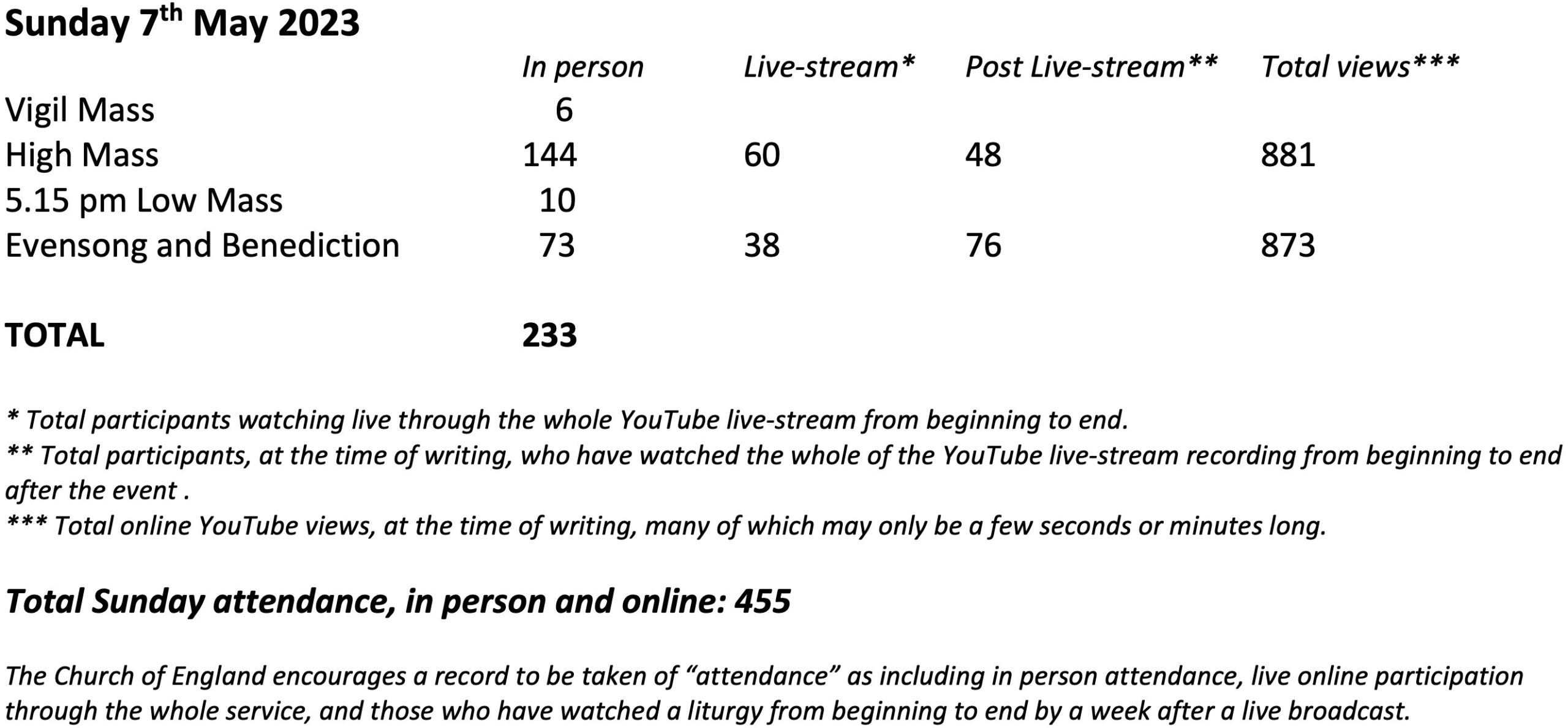
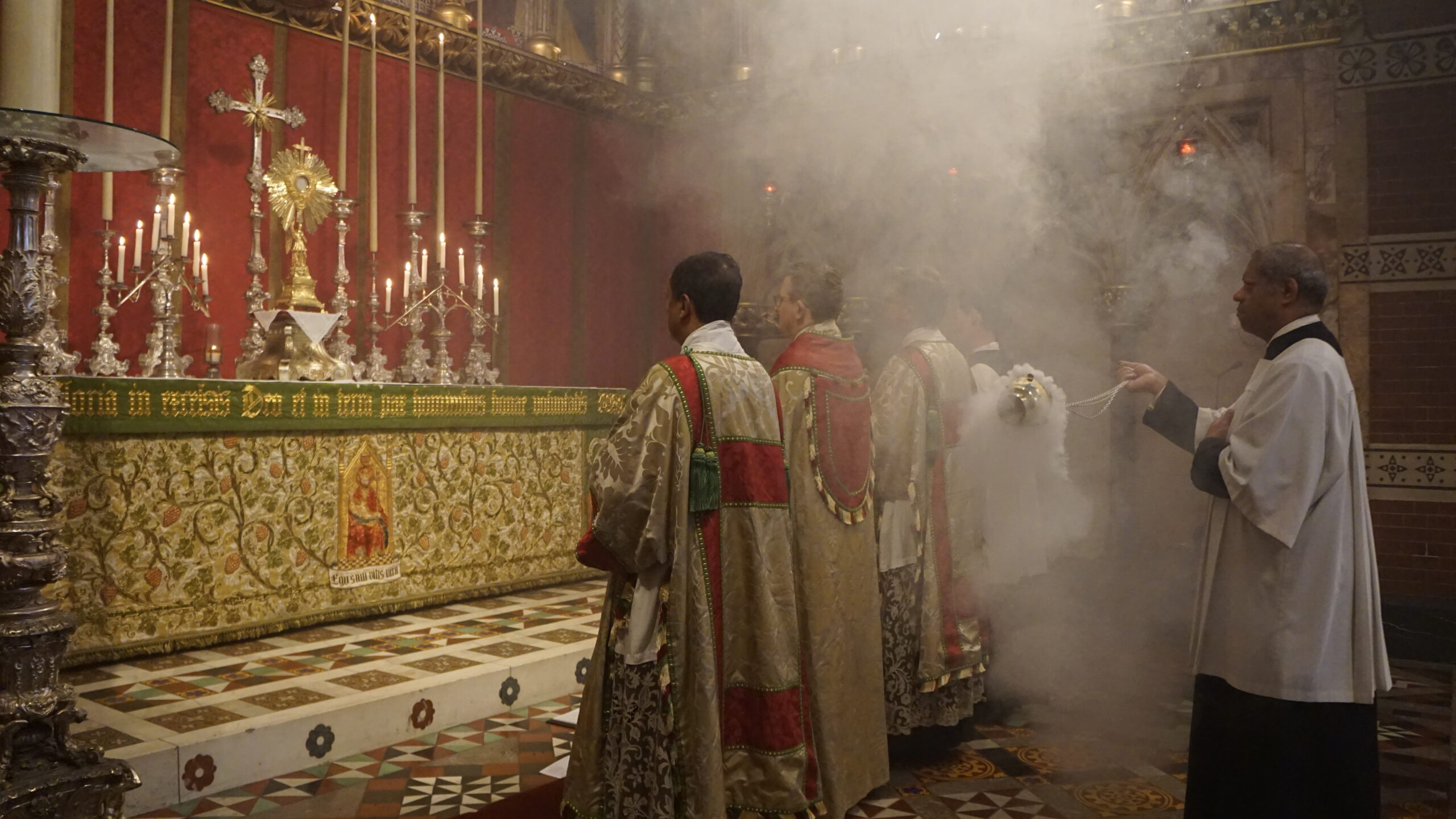
At Evensong and Benediction on Sunday night, a Te Deum was offered in the presence of the Blessed Sacrament in thanksgiving for the Coronation of Their Majesties the King and Queen. Our magnificent new Coronation Monstrance was used for the first time. Evensong was live-streamed and can be watched again here.
Links for Sunday
The links for the livestream and service sheet for this Sunday’s High Mass are at the end of this email.
Evensong and Benediction takes place at 6pm this Sunday. Music will include Philip Moore’s Third Service and Rheinberger’s Abendlied.
Prayer list
The sick
Fr. Harry Hodgetts, Amanda Barrett, Greg Loveday, Don McWhinney, Martin Berka, Pete Turner, James Rodger, Andrew Rodger, David Craig, Charles Thomson, Elizabeth Lyon, Ray Oram, Carol Lyman-Pryce, Keith Bevan, Marion Duggan, James Pearson, Eddie Burns
The faithful departed
Edna Moses
Anniversaries of death
May 14th – Patrick Spencer
15th – Elsie Rybczk, Winifred Beavan, Muriel Burling, John Carter
16th – Elsie Scott, Charles Simon, Richard Britten
17th – Lucy Heath, Wilhelmina Ward
18th – Michael White-Cooper Pr., William Crane, Thomas O’Neil Pr., Flora Clutterham, Charles Oram
19th – Frank Biggart, Mary Cottell, Betty Johnson
20th – Eliza Pountney, Eric Arnold
The Friends of All Saints’
May 14th – Edwin Holmes, Bp. David Hope, Richard Hoskinson, Fr. David Hutt, Andrew Jervis, Arthur Johnson, Malcolm Kemp
15th – Alan Kimbrough, Brenda Koupis, The Very Rev’d Harry Krauss, Deirdre Laing, Graham Last, Christopher Laws
16th – Cornelius Logue, Nigel Lynn, Henry Macey, Bp. Michael Marshall, Robert Mason, Judith Mather
17th – Fr. Stephen McClatchie, Fr. Peter McGeary, Nigel McNeill, John McWhinney, Colin Menzies, Anne Merritt, Thomas Moller
18th – Barry Moore, John Morrell, Fr. Stephen Morris, Inger Mosbery, Carol Mundell, Christopher Naylor
19th – Brian Newman, Graham Norman, Elaine Norman, Richard North, Fr. Paul Ockford, Anna and Fr. Peter Oesterby-Joergensen
20th – Fr. Barry Orford, Malcolm Parr, Bhaven Patel, Alma Pearson, Pat Phillips, Pamela Phillips
Service times this week
Saturday 13th May – Our Lady of Fatima
11.30 am Rosary
12.00 pm Mass of Our Lady
6.30 pm Vigil Mass of Sunday
Sunday 14th May – The Sixth Sunday of Easter
11.00 am High Mass
5.15 pm Mass
6.00 pm Evensong and Benediction
Monday 15th May – St. Mathias
12.00 pm Mass
6.30 pm Mass
Tuesday 16th May – Feria
12.00 pm Mass
6.30 pm Mass
Wednesday 17th May – Feria
12.00 pm Mass
6.30 pm Mass
Thursday 18th May – Ascension Day
12.00 pm Mass
6.30 pm High Mass
Friday 19th May – St. Dunstan
12.00 pm Mass
6.30 pm Mass
Saturday 20th May – St. Bernadine of Sienna
12.00 pm Mass of Requiem
6.30 pm Vigil Mass of Sunday
Sunday 21st May – The Sunday after Ascension Day
11.00 am High Mass
5.15 pm Mass
6.00 pm Evensong and Benediction
